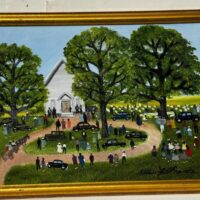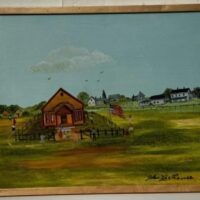No one makes brooms by hand anymore. Well, almost no one.
More than a century ago Jack Martin’s maternal ancestors, the Hockadays, began growing broomcorn alongside more conventional crops on the family farm in southwest Tennessee. It started as a hedge against the loss of income in the lean winter months. The hearty broomcorn — actually a variety of sorghum — reliably produced an abundant fall harvest that could be dried, stored, and fashioned into brooms until spring planting season. Brooms were subsequently traded for necessities or wholesaled to local merchants.

The Hockadays were not the only rural family who learned to supplement subsistence farming with broom making. From the mid-19th until the mid-20th century similar operations sprang up almost anywhere broomcorn could be cultivated. The Hockadays were, however, among a small handful of craftspeople whose reputation for quality brooms created a lasting demand for their products.
Jack Martin still makes brooms today, one at a time, on the same farm, and with the same homemade machines used by his great-grandfather. It’s an unlikely story of survival and success.
Predictably, it was the inexorable march toward mechanization; the introduction of cheaper, less labor-intensive, synthetic materials; and the advent of affordable vacuum cleaners that crowded out most small broom-making businesses. Yet, Hockaday Handmade Brooms thrives in McNairy County, Tennessee. That’s no fluke; it’s the direct result of Martin’s shrewd diversification and a contemporary approach to the craft that recognizes the broom as more than a utilitarian object.
The Folk Artist
Martin credit’s his wife, Virginia, with envisioning the artistic possibilities of a broom. From the outset of their relationship, Virginia was an outspoken advocate for the natural, aesthetic qualities of broomcorn and the near-miraculous survival of fading folkways in the Hockaday/Martin family. By the time she passed away in 2015, Virginia and Jack Martin had thoroughly reinvented the family farm and broom business as a hub for traditional handcraft preservation and agri-tourism.
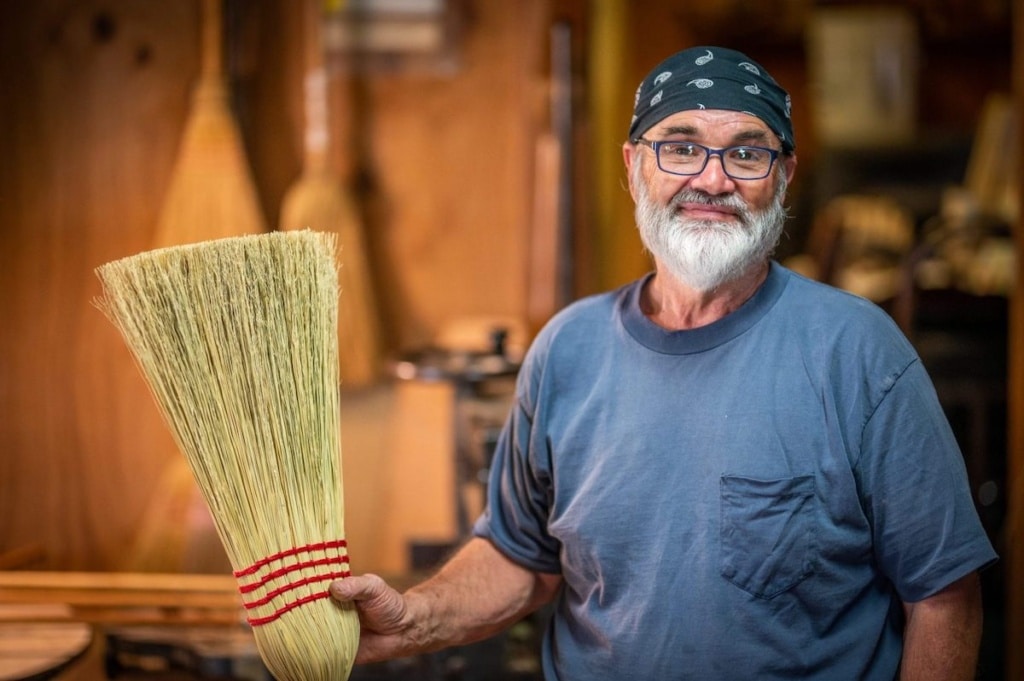
One of the first major changes that signaled a new direction for Hockaday Brooms was an open invitation to just come and see. Virginia had experienced first hand what it was like to be transported back in time by a fourth-generation craftsman who knew his work intimately and could speak with authority about the tradition’s significance to his family and community. She intuitively grasped that Jack Martin was his own best salesman, and calculated that others would be just as mesmerized by the deftness of his touch at the foot-treadle winding bench where he secured bristles to handle, and the antique broom press where he stitched the natural fibers into the familiar fan shape.
Virginia couldn’t have been more right. For almost 20 years the Hockaday Broomcorn Festival drew thousands of eager attendees to the farm for a day-long immersion in “the old ways,” as Martin styled it, while a steady stream of cultural tourists visited the shop for year-round tours and demonstrations. It’s impossible to resist a broom you’ve just witnessed coming together from a pile of straw. Trust me, I own more than a dozen.
Martin wisely availed himself of public programs and resources to spread the gospel of homemade brooms. For many years he participated in a state arts program that subsidized teaching and touring artists in the public school setting. By his own conservative estimate, Martin has demonstrated traditional broom making for more than a million schoolchildren. He has twice been selected for the Tennessee Traditional Arts Apprenticeship Program which is designed to preserve endangered traditions and art forms by pairing committed students with master artists. If the craft doesn’t survive, it won’t be from a lack of effort.
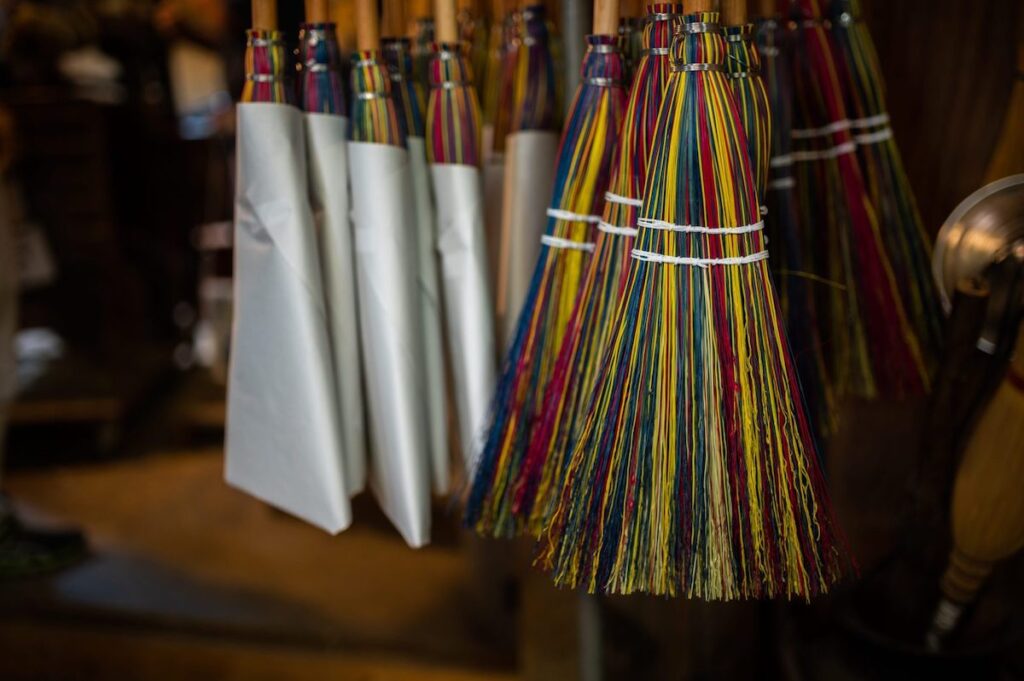
But the most satisfying validation of Virginia’s vision of her husband as an authentic folk artist and tradition bearer came shortly before her untimely passing, as Jack was honored with the Tennessee Governor’s Folklife Heritage Award. The recognition — among the state’s highest honors in the arts — is jointly bestowed by the Tennessee Governor and First Lady and the Tennessee Arts Commission. It’s a circuitous journey from the broom shed to the Governor’s Mansion, but as American music icon, Loretta Lynn, sagely observed at the ceremony, it’s a path as legitimate as any. Lynn, who said she was proud to be honored alongside Martin, extolled the virtues of his craft, adding that she’d never seen a store-bought broom until she left her home in Butcher Holler, Kentucky. It was a moment of levity that spoke to the depths of the tradition.
A Broom by Any Other Name
You can purchase a Hockaday Handmade Broom virtually identical to the ones Martin’s grandfather and great-grandfather made over a century ago. Discriminating sweepers still prize them for their usefulness, and you’re not likely to find a better, more durable broom anywhere, at any price. But Martin’s most popular models now come with decorative touches such as vibrant, multicolored broomcorn, attractively stained hardwood handles, and hand-carved details. They also come in a variety of sizes and forms from the archaic besom — think of a witch’s broom or Harry Potter’s Nimbus 2000 — to the miniature child’s broom, or custom orders like the bifurcated “honeymoon broom.” In each instance, the same commitment to quality guarantees that these variations are as functional as they are beautiful, but customers typically buy them as gifts or art objects rather than household utensils.
Maybe the most surprising innovation Martin introduced to the Hockaday product line was, of all things, a percussion accessory.
Jack and Virginia were both steeped in music long before they met. Virginia had a prestigious career as a vocalist performing and recording with well-known artists such as Eric Clapton, Joe Cocker, Greg Allman, Rufus Thomas, Allen Toussaint, John Mayall, and the Neville Brothers, to name a few, while Jack was an active and accomplished drummer.
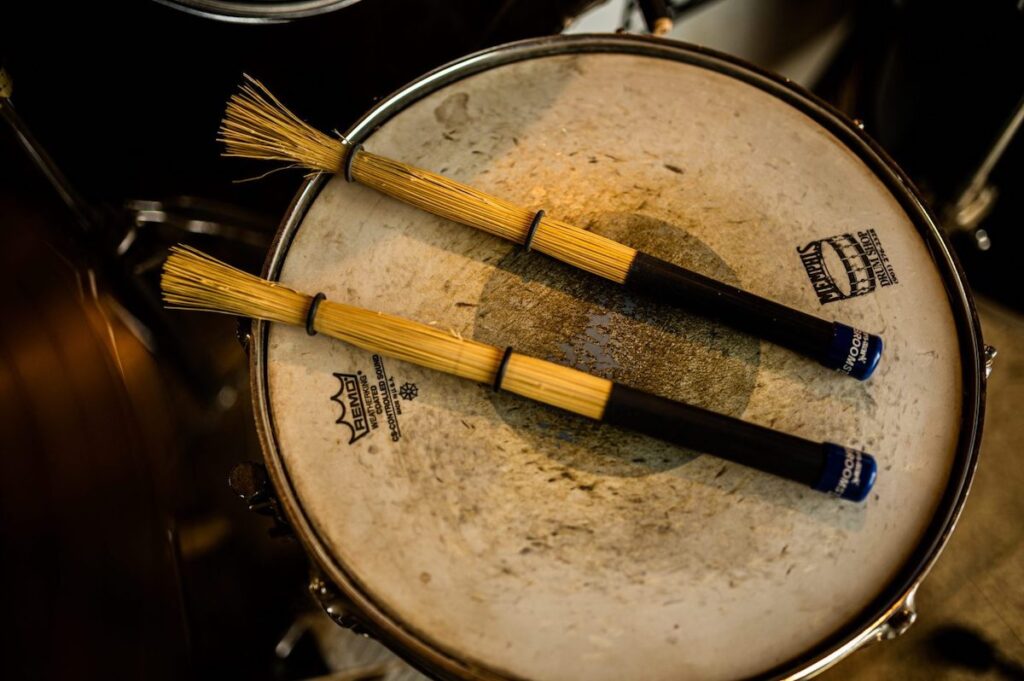
So perhaps it wasn’t so strange when Jack merged his two passions to create a brush-like bundle of natural broomcorn that could be used like a drumstick. He submitted the prototype to ProMark, one of the world’s leading drumstick makers, who eagerly embraced the concept and now markets the product under the trademarked name Broomsticks.
Initially, Broomsticks were made just like everything that came out of Martin’s shop: one at a time, with meticulous attention to detail. Each pair was sold with a brief history of Hockaday Handmade Brooms in the packaging and marketed as an artisan-grade item, which it clearly was. But when ProMark merged with D’Addario, another large musical accessory maker, his agreement to produce Broomsticks was suspended without notice, and any mention of Martin or Hockaday Brooms was promptly removed from the adverting and packaging. Almost every maker of percussion accessories now offers a knockoff of Martin’s invention, but the original item took root in the fertile imagination and fertile soil of a Tennessee farmer.
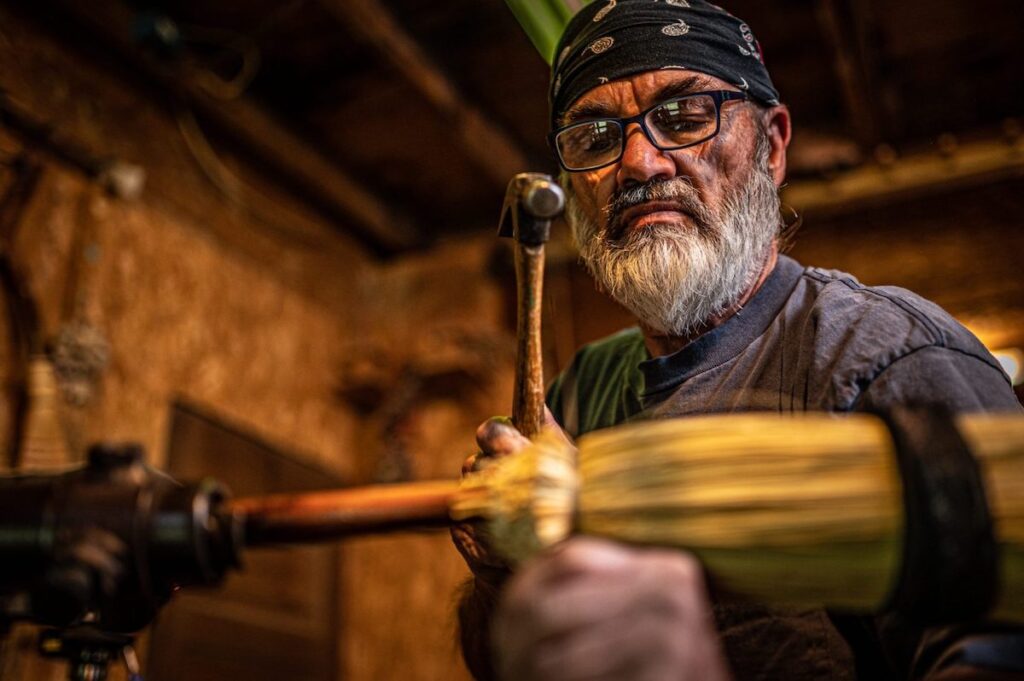
Sustainable Tradition
It may not have been unusual for a farm family to make ends meet by crafting brooms. That the practice has been adapted and amplified to appeal to contemporary craft collectors, folklife preservationists, and a new generation of percussionists is not just unusual, it’s extraordinary. It’s a testament to the resiliency of rural Americans like Jack Martin whose love of family and community serves as a foundation for building a satisfying and sustainable way of life that honors tradition and brings it responsibly forward into the twenty-first century.
When the broom maker became a storyteller out of necessity, it changed his life. He is content in both roles now, but his chapter in the story of Hockaday Handmade Brooms is still unfolding. It will be up to someone else to tell it all. He would like to be remembered as an honest farmer. He would like the work to be understood in the context of his family’s history. He hopes the traditional handcraft will survive and wants people to know how naturally Broomsticks flowed from the tributary streams of his life merging into one idea.
But tomorrow, there are brooms to be made.
Shawn Pitts is a community arts advocate who lives in Selmer, Tennessee. His writing has appeared in publications such as Southern Cultures and The Bitter Southerner. He has served on the boards of the Tennessee Folklore Society, Humanities Tennessee, and the Tennessee Arts Commission, as well as numerous economic and community development agencies.
Shawn Pitts is a founding director of Arts in McNairy. As a community arts advocate, Shawn has provided consulting services for rural arts agencies and presented widely on the rewards and challenges of cultural planning. His writing has appeared in Southern Cultures, The Tennessee Folklore Society Bulletin, and The Bitter Southerner among other periodicals. Shawn has served on the boards of The Tennessee Folklore Society, Humanities Tennessee, and The Tennessee Arts Commission, as well as numerous economic and community development agencies. He lives in Selmer, Tennessee.

